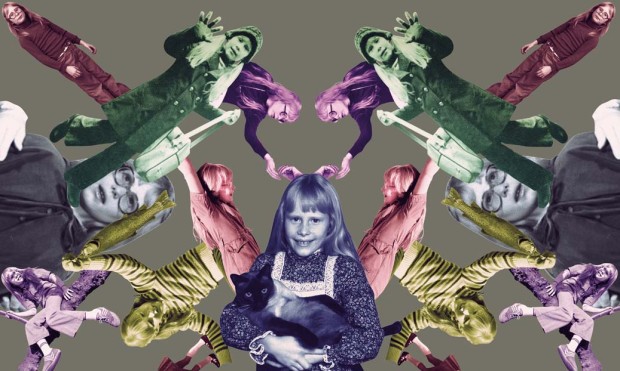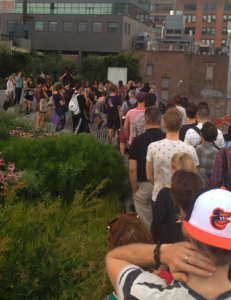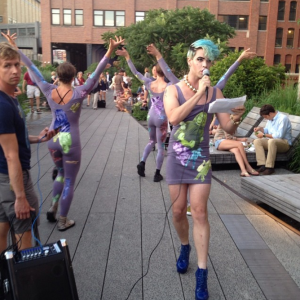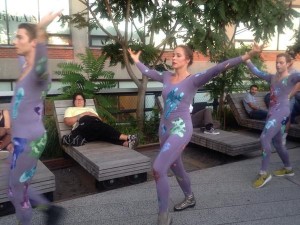Artist Ryan McNamara, known for outlandish performances—from a ballet about the Internet to artists buried in dirt singing love anthems—presented his new piece, “Misty Malarky Ying Yang,”at the High Line last Wednesday and Thursday (Tuesday’s performance was cancelled due to a downpour). For this 25-minute-long performance-cum-parade, dancers wearing leotards covered with pictures of Jimmy Carter’s daughter and her cat (named “Misty Malarky Ying Yang”) proceeded down the High Line as they recited and danced to the former president’s “Malaise Speech.” This year marked the 35th anniversary of the speech, in which he diagnosed a “crisis of confidence” in the American people, who lacked trust in both the government and the country’s future.
This was a performance that used very little means (not much more than leotards and a speaker) to achieve a huge impact. Here’s what we had to say about the piece, but basically, it was just really good.
Henry:
 Just the specificity of reciting the “Malaise Speech” was enough to make the performance seem absurd: The speech is really oddly philosophical and nebulous for a presidential address. In the text of the speech, president Carter talks about a “crisis of confidence,” or a “growing doubt about the meaning of our own lives and in the loss of a unity of purpose for our nation.” Needless to say it is oddly lofty and critical. Or at least it has been remembered that way historically.
Just the specificity of reciting the “Malaise Speech” was enough to make the performance seem absurd: The speech is really oddly philosophical and nebulous for a presidential address. In the text of the speech, president Carter talks about a “crisis of confidence,” or a “growing doubt about the meaning of our own lives and in the loss of a unity of purpose for our nation.” Needless to say it is oddly lofty and critical. Or at least it has been remembered that way historically.
On top of it all, the speech was then recited by dancers who sounded like a high school cheerleading troupe that didn’t have a football team to root for. The impassioned words of Jimmy Carter were chanted with a vapid, “go team go” cadence. The speech started out “Exactly three years ago. On July 15. 1976. I accepted. The nomination. Ooooof my party. To run for president of the Uni-ted-States.”
At a point, dancers chant something along the lines of “The economy. Is. Deeeeeclining.” At that moment, all the dancers fall to the ground. The choreography has this hilarious literalness, like it was created by a child who doesn’t yet quite grasp the concept of symbolism. The words “economic decline” must be coupled with a literal fall. So the dance moves ended up being the final farcical straw. (Well, except for at the very end of it all, when a drag queen with blue hair began singing Jimmy Carter’s impassioned words about energy conservation.)
All these elements together gathered a curious and pretty large crowd. I heard one tourist say, “Well this is just absurd for the sake of being absurd.”
So was there a point behind all the absurdity? The content of Carter’s speech is obviously about American overconsumption, but I don’t think that was what “Misty Malarky Ying Yang” was about.
Andrew:
I completely agree that the absurdity was what made this performance so great. From the unitards outfitted with awkward photos of Jimmy Carter’s daughter Amy to moments like when the dancers jumped on top of chairs that people were lounging in, this was a performance that was just plain fun to watch. And I could see why a viewer might leave the piece thinking that this was absurdity for absurdity’s sake–but I think there was something deeper going on.
I took the entire performance to be the inverse of how we normally think of Carter’s infamous speech. Carter never actually uses the word “malaise,” and it’s only in our cultural imaginations that the speech has been remembered that way. McNamara turned the speech into what it always should have been: an uproarious call to action.
As the dancers made their way up the High Line, the crowd following along looked like they became part of the piece—turning the whole thing into a parade for Jimmy Carter. While Carter’s original speech only led to dwindling support, McNamara’s performance had viewers and passersby constantly joining in the celebration, even if they didn’t know what exactly they were joining in on. Everyone wants to be part of the party, I guess.
And while many passersby may have initially joined in the crowd purely for the exuberant theatrics, invariably they ended up having to listen and contend with the words of the speech.
That, for me, was where “Misty Malarky Ying Yang” (again, the name of Amy Carter’s cat) became most poignant. Little in what the dancers chanted explicitly referred to 1979, and I imagine that the High Line’s many tourists assumed the performance was referring to the present, and not the past. Quotes like “The threat is nearly invisible in ordinary ways. It is a crisis of confidence. It is a crisis that strikes at the very heart and soul and spirit of our national will” took on a whole new power, and could have referred to our own present-day attitudes towards the wars abroad. The fact that so little seems to have changed since Carter initially gave the speech lent a somber subtext to this otherwise raucous performance.
Henry:
Yeah, that’s a great point.
I agree that the audience acted like a parade for the dancers, a dedicated group of followers who showed up to support the words of Jimmy Carter. But, in reality, that’s not at all what was going on. It seemed there was this two-tiered audience: the people who showed up at the High Line to see the performance and the unsuspecting men and women just visiting the High Line on that afternoon.
This use of the audience reminds me of McNamara’s 2012 show Still, but this seems even more sophisticated than that. In Still, McNamara snapped pictures of audience members as if they were told to be props in an installation. But with “Misty Malarky Ying Yang,” simply by watching the the performance, the spectators became part of the performance itself. It’s this light-handed consideration and control that McNamara has—and which most artists don’t have when they attempt audience participation—that made me give kudos to this work.






Comments on this entry are closed.